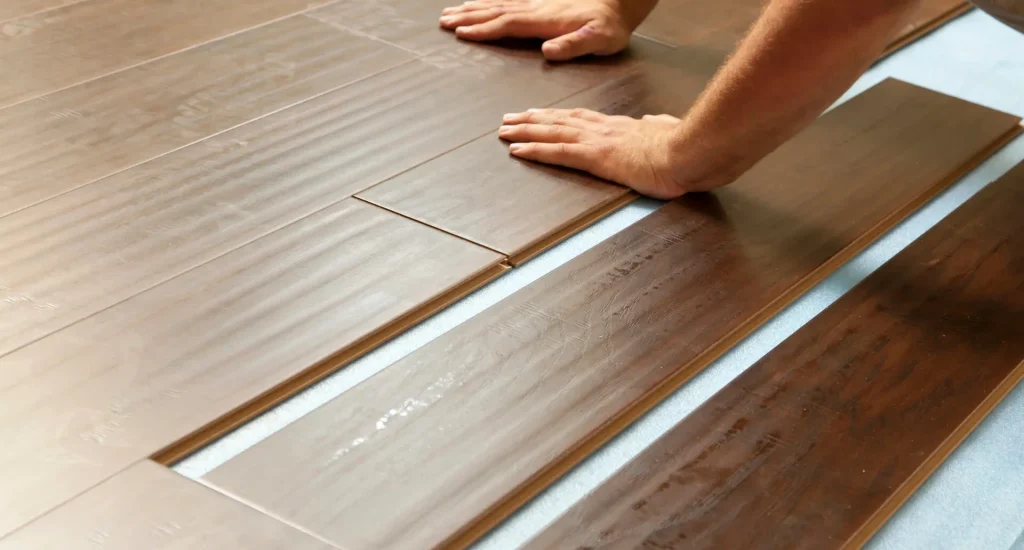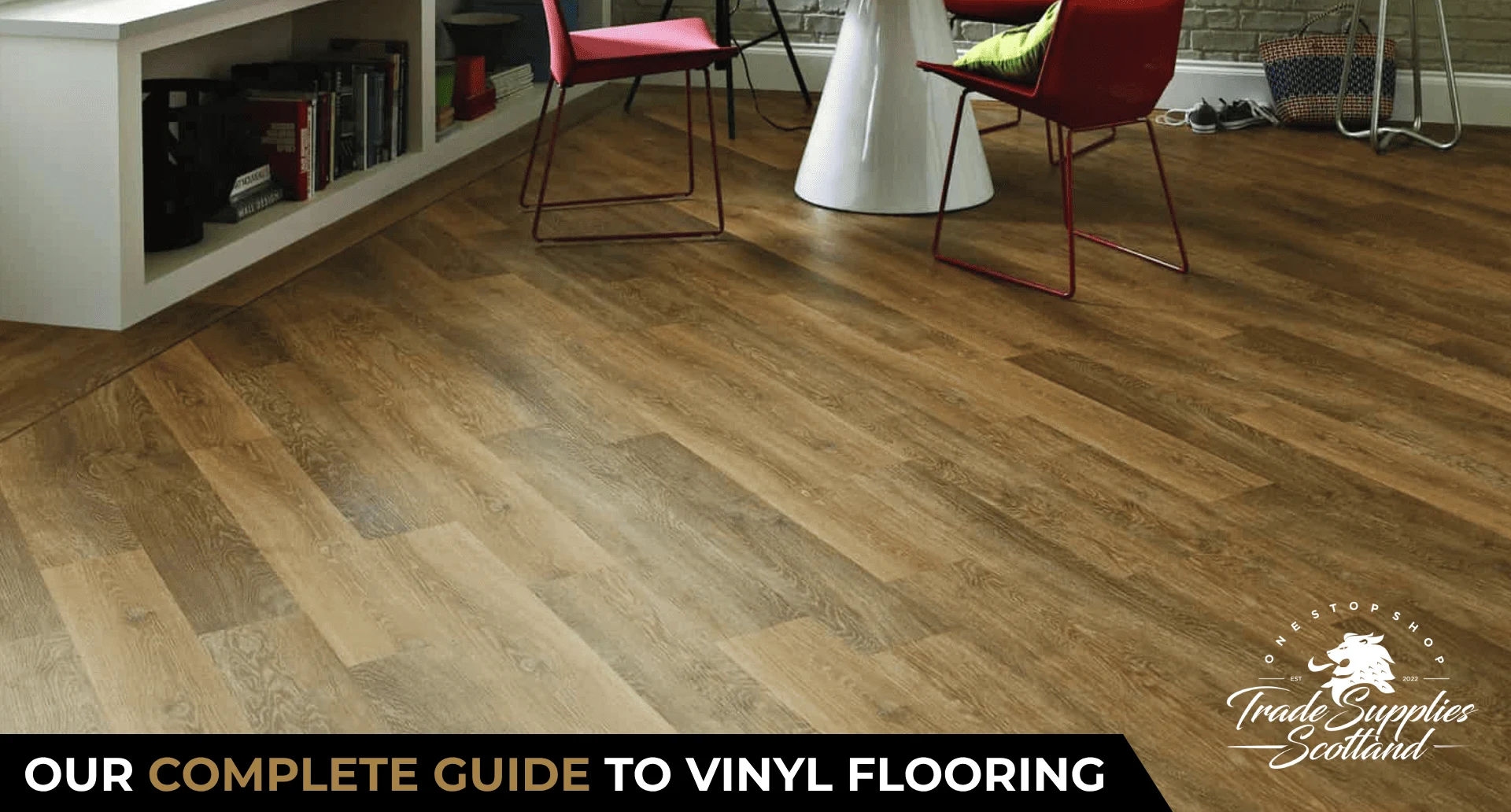Our complete guide to vinyl flooring
Vinyl flooring is a popular, durable, and versatile choice for both residential and commercial spaces. It comes in a variety of styles, textures, and price points, making it a great option for many types of projects. Here’s a comprehensive guide to help you understand vinyl flooring and choose the right type for your needs:
1. Types of Vinyl Flooring
There are three main types of vinyl flooring, each with its own benefits and uses:
A. Vinyl Sheet Flooring
• Description: Comes in large, continuous rolls. It is typically installed by laying it down and cutting it to fit the space.
• Advantages: Seamless, water-resistant, and great for moisture-prone areas like bathrooms or kitchens.
• Best for: Large rooms or spaces where you want fewer seams for a more uniform look (e.g., bathrooms, kitchens, laundry rooms).
B. Vinyl Plank Flooring (LVP – Luxury Vinyl Plank)
• Description: Resembling hardwood, vinyl planks come in individual pieces or tiles. It often features click-lock installation or glue-down options.
• Advantages: Highly durable, water-resistant, available in wood-look designs, easy to install (especially with click-lock systems), and low maintenance.
• Best for: Living rooms, bedrooms, and high-traffic areas, as well as bathrooms and kitchens.
C. Vinyl Tile Flooring (LVT – Luxury Vinyl Tile)
• Description: Vinyl tiles mimic the look of natural stone, ceramic, or marble. Like vinyl planks, they are available in adhesive or click-lock formats.
• Advantages: Water-resistant, scratch-resistant, available in a variety of textures and designs, and easy to maintain.
• Best for: Bathrooms, kitchens, or any area where the look of stone or ceramic tiles is desired without the weight and expense.
2. Key Features to Consider
A. Durability
Vinyl flooring is generally durable, but different types and styles offer varying levels of resilience. Thickness, wear layer, and overall construction impact longevity.
• Wear Layer: The protective coating on top of the vinyl. Thicker wear layers (12 mil to 30 mil or more) provide greater protection against scratches, stains, and wear. This is especially important for high-traffic areas.
• Top Coating: Some luxury vinyl tiles/planks have enhanced coatings for additional protection, especially in commercial-grade products.
B. Water Resistance
Vinyl flooring is well-known for being water-resistant. This makes it an excellent option for kitchens, bathrooms, basements, and laundry rooms.
• Fully Waterproof Options: Some premium vinyl options, especially luxury vinyl planks (LVP) and tiles (LVT), are fully waterproof. These products feature tight seams and can handle water exposure without swelling or damage.
C. Ease of Installation
Vinyl flooring comes in a range of installation methods:
• Glue-Down: Traditional method where adhesive is used to secure the vinyl to the subfloor.
• Click-Lock: A floating floor system that requires no glue. The planks lock together via a tongue-and-groove system, making installation easier for DIYers.
• Loose Lay: The vinyl is heavy enough to stay in place without glue or click-locking. It’s easy to replace individual pieces if needed.
• Peel-and-Stick: Available for tiles, these are self-adhesive and easy to install, though less durable over time compared to click-lock or glue-down systems.
D. Comfort and Sound
Vinyl is generally softer and warmer underfoot than ceramic or stone tiles. You can add underlayment to enhance comfort, reduce noise, and add insulation.
• Underlayment: Some vinyl floors come with attached underlayment, while others require additional padding beneath the flooring to improve comfort and sound insulation.

3. Aesthetic Options
A. Styles
• Wood-Look Vinyl: Vinyl planks and tiles that mimic the appearance of hardwood. It’s available in a variety of finishes, including oak, maple, and even exotic woods like walnut or hickory.
• Stone or Ceramic-Look Vinyl: Tiles designed to replicate natural stone, marble, or ceramic tiles. These can offer the upscale look of high-end materials without the high price.
• Solid Color Vinyl: Single-color vinyl sheets, often used in commercial or industrial spaces, but also available for residential areas in modern designs.
• Patterned Vinyl: Includes designs like geometric, mosaic, or floral patterns. These are often used in bathrooms, kitchens, or spaces where a bit of style is desired.
B. Color Options
Vinyl flooring is available in a wide range of colors, from light, natural tones to dark, rich hues. It’s important to choose a color that matches your space’s overall aesthetic and functional needs.
4. Maintenance and Care
• Cleaning: Vinyl flooring is very easy to maintain. Regular sweeping or vacuuming is usually enough. For deep cleaning, use a damp mop with a mild detergent (avoid harsh chemicals).
• Stain Removal: Vinyl is resistant to most stains, but sticky substances or tough stains can be removed with a gentle cleaner. Avoid abrasive scrubbers, as they may scratch the surface.
• Polishing: Some vinyl floors can be polished for added shine, but this is usually unnecessary unless you want to restore a high-gloss look.
5. Cost Considerations
• Budget-Friendly: Standard vinyl sheet flooring is usually the most cost-effective option.
• Mid-Range: Vinyl planks and tiles (LVT/LVP) can be more expensive, but they offer better aesthetics and durability.
• High-End: Luxury vinyl flooring with high-end designs and premium durability can be more expensive, but it mimics high-quality materials like hardwood or stone at a fraction of the cost.

6. Environmental Impact
• Recyclability: Some brands of vinyl flooring offer more eco-friendly options, such as recyclable materials, low-VOC emissions, and products made from recycled content.
• Sustainability: Look for certifications like GreenGuard or FloorScore, which indicate low levels of harmful chemicals and better indoor air quality.
7. Pros and Cons
Pros:
• Affordable and budget-friendly.
• Water-resistant or waterproof, perfect for wet areas.
• Low maintenance and easy to clean.
• Variety of styles and looks.
• DIY installation is often possible, especially with click-lock or peel-and-stick options.
• Comfortable underfoot compared to hard materials like stone or ceramic.
Cons:
• Can be scratched or dented by heavy furniture or sharp objects.
• Lower-end products can fade over time, especially in direct sunlight.
• Some vinyl flooring (especially cheaper options) can have a less premium feel or appearance.
• Not as environmentally friendly as natural flooring options (although some brands are improving their sustainability).
8. Installation Tips
• Preparation: Ensure your subfloor is clean, dry, and level. Most vinyl flooring can be installed over existing floors as long as the surface is smooth.
• Acclimation: Allow vinyl planks or tiles to acclimate to room temperature before installation to prevent expansion or contraction.
• Seams and Transitions: Pay attention to how seams are laid, especially with sheet vinyl. Transition strips may be necessary where the vinyl meets another type of flooring or at doorways.
Conclusion
Vinyl flooring is an excellent choice for homeowners and renters looking for a versatile, affordable, and durable flooring option. With a wide range of styles, ease of maintenance, and water resistance, vinyl can fit nearly any space, from bathrooms and kitchens to living rooms and bedrooms. Consider your budget, desired look, and installation preferences when choosing the best type for your home.
If you have any further questions then please contact us and we will be more than happy to help!


